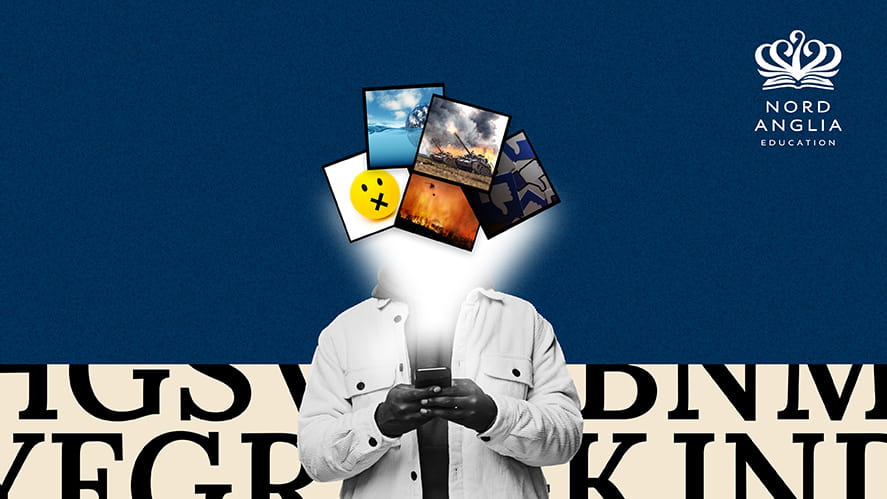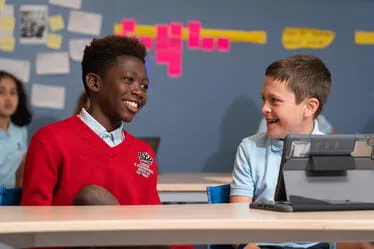

Jodie Jackson has an audacious goal: to completely change children’s relationships with the news.
Having spent more than a decade researching and exploring how the news impacts us, in 2019 she published You Are What You Read: why changing your media diet can change the world, followed up with a 2020 children’s book Little Ruffle and The World Beyond. In 2022, she presented Beyond fake news: how to heal a broken worldviewat the TEDxLondon stage, which has been viewed more than 10,000 times.
And since 2021, she’s been building the News Literacy Lab, which offers news literacy programmes to “empower young people by equipping them with essential skills to navigate the news in today’s world”.
It’s a timely skill set. Research published by the University of Oxford in 2022found that only around a third of 18- to 24-year-olds trust most news (compared with more than half of those aged 55 and above), and that around four in 10 of those under 35 often or sometimes avoid the news. A shocking 82% of middle-schoolers couldn’t distinguish between an ad labelled “sponsored content” and a real news story on a website, according to a Stanford University study of 7,804 students from middle school through college.
Researchers from the University of Liverpool found that participation in the News Literacy Lab left students “feeling more equipped to evaluate the credibility of news sources”, and to be “aware of their own biases and those of media organisations”. Importantly, it also helped students feel more hopeful about the world and their role within it, with an emphasis on ‘solutions-focused journalism’, which aims to present a more complete picture by highlighting responses and potential solutions to issues.
We spoke to Jodie to understand what she thinks young people need to know about navigating the news, how news is made and how to help young people construct a healthy news diet.
Like many people, you’ve had a complex relationship with the news. How did that lead you to create the News Literacy Lab?
When I was around 21 or 22, I just couldn't stand the news anymore. It made me feel so depressed about the world and so hopeless about the future, because of seeing terrible, terrible things happening daily. I decided to switch off from it but found that was nearly impossible because the news is everywhere. It will find you, whether it's through a radio programme, a conversation with a friend, or just standing in a queue at the shops where you can see the front pages. It's everywhere. I felt like turning off didn't really fix the problem I was trying to solve. It made me feel slightly less bad slightly less often, but it didn't make me feel significantly better.
So I started a (now defunct) website called What A Good Week, which was an aggregator platform of solutions-focused news. And I had such a profound shift in myself from changing my media diet that I wanted to understand it more rigorously, so I went back to university and did a master's in positive psychology, because I wanted to understand concepts like hope, optimism, resilience, post-traumatic growth. I wanted to understand what the conditions for them are, and what the impact of them is. There was very little research at the time around solutions-focused content, so that's what I created my thesis on.
But then when Covid hit, I realised that even with everything that I had learned, I couldn't be an effective mediator between my three children and their information spaces. So I wrote a children's book that addressed some of this. I went on to create some resources for teachers for seven- to 11-year-olds, and at that point, I realised I was teaching young people how to have a healthy relationship with news. I was teaching them to create a balanced understanding of the world and empower them to be able to act within it.
How does your work differ from other news literacy programmes?
News literacy is becoming more valued as a practice, but a lot of it can be quite one-dimensional and quite impractical. A lot of news literacy programmes are very much about fake news, and overly burdening consumers with the responsibility of fact-checking and verifying. This can be unhelpful, especially because so many people are disengaging from the news.
I've learned over the last five years that fake news is not the only contributor to a misinformed worldview. Our curriculum does have a fake news element, but we also look at the negativity bias, solutions journalism, and we look at human psychology. This is to understand how our brains process information and what biases are built into our news.
What’s the issue for children with the way the news tends to be reported?
The negativity bias has an enormous role in misrepresenting reality and creating a distorted, disempowering and disconnected perspective. There are many damaging consequences of focusing predominantly on problems. It's fine to feel worry, fear, anger and outrage, but the problem is that we only feel those feelings. We don’t combine them with optimism, hope, agency and connection, and so we’re left in this overwhelmed and isolated state and that's not helpful for ourselves or for society.
The news creates this enormous sense of urgency, but when you have urgency with no sense of agency, you feel overwhelmed. It creates a kind of pessimistic paralysis. You are stuck. We know what the problem is, but how do we do something about that? How do we move it forward? Who's doing something to successfully address it? Solutions-focused news creates possibility, and that not only improves your mood, it shifts your mindset and broadens your choice and your abilities.
It's not enough for journalists to tell us stories about problems in the hope that we change, we also need solutions to help us change. Whilst this is needed, it is not often provided because most mainstream news organisations are not currently designed to tell stories about solutions. Fortunately, there are some brilliant and well-resourced organisations that can provide good quality, solutions-focused news.
What are some of the problems with solutions-oriented news?
Primarily, that it is done badly. It is still a very misunderstood and poorly practised strand of journalism. But there are some incredible organisations pioneering the way and creating brilliant frameworks such as the Solutions Journalism Network.
In a world full of problems, is a focus on positivity warranted?
Yes, because problems and solutions co-exist. It is, in fact, deceptive to only be telling a story of a world in crisis because it creates a distorted perception of reality. It creates a misrepresentation and as a result, many people become misinformed and disempowered. Not only this, but learning from how communities are successfully responding to problems provides critical information that helps us better identify and implement effective action that can help us better respond.
How much does social media play into these issues?
Social media platforms are one of the least reliable spaces to become informed because they are designed to engage us, not inform us: one MIT study found that fake news spreads six times faster than real news on Twitter. We've got to understand that these platforms are risky by design.
Awareness can do a lot. Understanding that the algorithms are there, and how they work, means we can think about how we can bring in more reliable tools and engineer it so that we get more of what is good for us and less of what is bad for us. The amount of content that is produced is infinite, but our time is finite. So if we bring in some really good habits, and we can set up good foundations that will naturally tear away some of the bad stuff anyway.
And what sort of impact are you seeing on students?
I start the course by saying we're going to cover three main questions: what is the news, why do we have it, and how do we use it? But before any of that, we explore how the news makes them feel. And the students' answers are things like pessimistic, worried, hopeless, stressed, anxious, scared, angry and so on. That is their baseline. And when they finish the course, the words they offer are things like hope, optimism, happiness, confidence, a completely different type of vocabulary.
One of the biggest areas of interest is climate, it comes up again and again. The students say it is good to see more solutions-based news, rather than all of the negativity surrounding the environment. It’s powerful to see that progress is possible and that it's taking place somewhere.
People think if you care, you'll take action. Reverse that. If you take action, you'll care. The other thing that's really good about taking action is that it helps with feelings of anxiety because anxiety is a feeling about an undesired future, often combined with a feeling of a lack of control. But if you do something, it brings you into the present and gives you that sense of control.
What advice would you give to parents around news literacy?
You’ve got to be careful about how you source solutions-focused news because there is a difference between quality journalism that really helps you understand how issues are being dealt with and inspires you and empowers you, and the shoddy form of it, which is the uplifting, feel-good, hero-worshipping type, which seems like it’s offering solutions, but it's not.
The best newsletter I’ve found is one called Future Crunch, it’s a great source of solutions-focused journalism, and there's an organisation called Pique Action, which is solely solutions-focused content. There's a podcast called People Fixing the World, and an app called Squirrel News. I have those bookmarked on my homepage so that if I want to look at the news, I know exactly where to go.
If you adopt some of these practices as a parent, you’ll be able to lead this conversation with more authenticity because you will genuinely have this for yourself as well. When you're subscribing to solutions-focused news, it will give you a different perspective on the world—not by shielding yourself from the problems—but by allowing yourself to see what's possible in the presence of them. That will create a transformation in your understanding and your own mental health, and you will be able to create and offer space for your child.